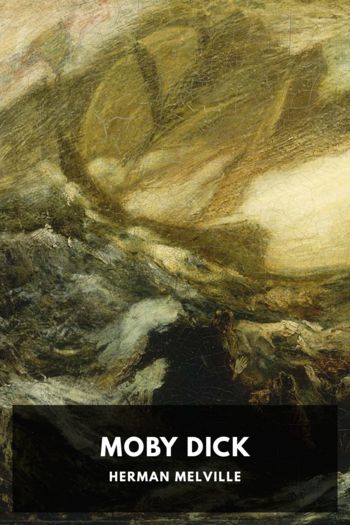Moby Dick Herman Melville (polar express read aloud TXT) 📖

- Author: Herman Melville
Book online «Moby Dick Herman Melville (polar express read aloud TXT) 📖». Author Herman Melville
See subsequent chapters for something more on this head. ↩
I am aware that down to the present time, the fish styled Lamatins and Dugongs (Pigfish and Sow-fish of the Coffins of Nantucket) are included by many naturalists among the whales. But as these pigfish are a noisy, contemptible set, mostly lurking in the mouths of rivers, and feeding on wet hay, and especially as they do not spout, I deny their credentials as whales; and have presented them with their passports to quit the Kingdom of Cetology. ↩
Why this book of whales is not denominated the Quarto is very plain. Because, while the whales of this order, though smaller than those of the former order, nevertheless retain a proportionate likeness to them in figure, yet the bookbinder’s Quarto volume in its dimensioned form does not preserve the shape of the Folio volume, but the Octavo volume does. ↩
With reference to the Polar bear, it may possibly be urged by him who would fain go still deeper into this matter, that it is not the whiteness, separately regarded, which heightens the intolerable hideousness of that brute; for, analysed, that heightened hideousness, it might be said, only rises from the circumstance, that the irresponsible ferociousness of the creature stands invested in the fleece of celestial innocence and love; and hence, by bringing together two such opposite emotions in our minds, the Polar bear frightens us with so unnatural a contrast. But even assuming all this to be true; yet, were it not for the whiteness, you would not have that intensified terror.
As for the white shark, the white gliding ghostliness of repose in that creature, when beheld in his ordinary moods, strangely tallies with the same quality in the Polar quadruped. This peculiarity is most vividly hit by the French in the name they bestow upon that fish. The Romish mass for the dead begins with Requiem eternam (eternal rest), whence Requiem denominating the mass itself, and any other funeral music. Now, in allusion to the white, silent stillness of death in this shark, and the mild deadliness of his habits, the French call him Requin. ↩
I remember the first albatross I ever saw. It was during a prolonged gale, in waters hard upon the Antarctic seas. From my forenoon watch below, I ascended to the overclouded deck; and there, dashed upon the main hatches, I saw a regal, feathery thing of unspotted whiteness, and with a hooked, Roman bill sublime. At intervals, it arched forth its vast archangel wings, as if to embrace some holy ark. Wondrous flutterings and throbbings shook it. Though bodily unharmed, it uttered cries, as some king’s ghost in supernatural distress. Through its inexpressible, strange eyes, methought I peeped to secrets which took hold of God. As Abraham before the angels, I bowed myself; the white thing was so white, its wings so wide, and in those forever exiled waters, I had lost the miserable warping memories of traditions and of towns. Long I gazed at that prodigy of plumage. I cannot tell, can only hint, the things that darted through me then. But at last I awoke; and turning, asked a sailor what bird was this. A goney, he replied. Goney! never had heard that name before; is it conceivable that this glorious thing is utterly unknown to men ashore! never! But some time after, I learned that goney was some seaman’s name for albatross. So that by no possibility could Coleridge’s wild Rhyme have had aught to do with those mystical impressions which were mine, when I saw that bird upon our deck. For neither had I then read the Rhyme, nor knew the bird to be an albatross. Yet, in saying this, I do but indirectly burnish a little brighter the noble merit of the poem and the poet.
I assert, then, that in the wondrous bodily whiteness of the bird chiefly lurks the secret of the spell; a truth the more evinced in this, that by a solecism of terms there are birds called grey albatrosses; and these I have frequently seen, but never with such emotions as when I beheld the Antarctic fowl.
But how had the mystic thing been caught? Whisper it not, and I will tell; with a treacherous hook and line, as the fowl floated on the sea. At last the Captain made a postman of it; tying a lettered, leathern tally round its neck, with the ship’s time and place; and then letting it escape. But I doubt not, that leathern tally, meant for man, was taken off in Heaven, when the white fowl flew to join the wing-folding, the invoking, and adoring cherubim! ↩
Since the above was written, the statement is happily borne out by an official circular, issued by Lieutenant Maury, of the National Observatory, Washington, April 16th, 1851. By that circular, it appears that precisely such a chart is in course of completion; and portions of it are presented in the circular. “This chart divides the ocean into districts of five degrees of latitude by five degrees of longitude; perpendicularly through each of which districts are twelve columns for the twelve months; and horizontally through each of which districts are three lines; one to show the number of days that have been spent in each month in every district, and the two others to show the number of days in which whales, sperm or right, have been seen.” ↩
The following are extracts from Chace’s narrative: “Every fact seemed to warrant me in concluding that it was anything but chance which directed his operations; he made two several attacks upon the ship, at a short interval between them,





Comments (0)